|
FAQs on Freshwater Worms of All Sorts, Identification
3 Related Articles:
Invertebrates for Freshwater Aquariums by Neale Monks,
Choose Your Weapon: Freshwater Fish Disease Treatment Options by Neale
Monks,
Related FAQs:
FW Worm
Identification 1, FW Worm ID 2,
FW Worm ID 4, FW Worm ID
5, Freshwater Worms 1,
Freshwater Worms 2, Planaria, FW Worm Behavior,
FW Worm Compatibility/Control,
FW Worm Selection,
FW Worm Systems,
FW
Worm Feeding, FW Worm Disease,
FW Worm Reproduction & FAQs
on: Worm Caused Diseases,
Worms as Foods,
FW Invert.s 1,
Aquatic Insects,
Crustaceans, Shrimps,
Terrestrial Hermit
Crabs,
|
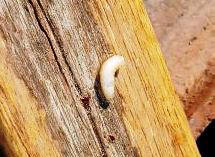 |
|
Worm Identification
2/27/18
I just bought an existing Aquaponic business and these worms are in my deep
water culture grow beds and want make sure they are not parasitic and
accidentally get transferred via the food I will be harvesting. Please help me
identify if possible....
The photos are the bottom of my shopvac from cleaning out one of the grow beds.
Thank you in advance for your assistance. Cas
<Hello Cas. Can't possibly identify what these are without sharper photos of
individual worms. Indeed, identifying worms to species level usually requires a
microscope. These look harmless enough, but if you're doing this to grow food,
you really do want to be 100% sure. You don't state whether these are from
marine, brackish or freshwater beds, or whereabouts you are in terms of local
climate and geography. All this is important when trying to ID worms. Cheers,
Neale.>
|
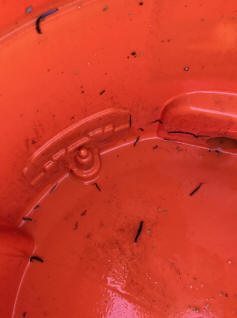 |
|
Re: Worm Identification
2/27/18
Thanks for the quick response Neale. I am in Galveston Texas, so on the coast.
The Aquaponic system is freshwater (in greenhouse). There have been no fish in
the system for over a year, they had a massive die off due
to neglect. There has been constant aeration the entire time but no system pump.
It is fed by rain water and I'm sure thee worms have been feeding off of the
dead plant debris at the bottom of the tanks. I have attached a
couple more photos and have tried to zoom in a little. I know it's hard but I
live on a island with very little resources for identification and you were my
last hope. They seem to vary in size as they move. the back
end us usually the thickest and as they move they stretch out almost three to
four times their body length. They are mostly brown but some of the smaller ones
seem to be a bit grey/brownish. Thanks for whatever you can
do or if you provide another way to go about identifying I would appreciate it!
<Understood. Some of the flatter brown worms with vague rounded ends look like
carnivorous or scavenging leeches -- which despite the leech name are perfectly
harmless and not the sort that bite people (in fact only a
minority of leeches eat blood, and even fewer pose a risk to humans). The
thinner, more tube-shaped ones are probably oligochates of some sort, related to
earthworms, and again, almost certainly harmless. You could
identify these two groups yourself with a hand-lens or microscope --
oligochaetes are segmented, taper to a point at each end, and have sparse
bristles along their bodies. You quite probably examined an earthworm as a
child, and maybe heard the bristles scratch against paper as the worm moved; I
certainly did that at school. Leeches are segmented, lack the bristles, but do
have distinctive suckers at each end used to hold themselves in place. They are
mostly aquatic, and swim with a rather beautiful snake-like undulation that's
quite lovely to watch. The other types of worms you're likely to see are
nematodes and nematomorphs, both of which lack segments, but distinguishing
these is a bit harder. Nematodes tend to be pointy at each end and otherwise
featureless. Nematomorphs are often very long and thread-like. There are
parasites among bother groups,
which do have vectors that can move them about to the most unexpected places, so
while the majority of species are harmless, you would want to get them
identified professionally if you're involved in commercial food
production. Hope this helps, Neale.>
|
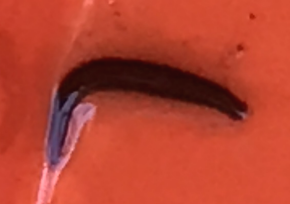 |
Re: Worm Identification
it does. thank you so much for your time and explanations!
<Most welcome. Neale.> |
|
Worms 1/20/18
Hello my name is Mehrr, and I've found these work like creatures in my
fresh water tank. Could you please tell me what they are?
<Are these in your aquarium? Seems odd. These are maggots of some sort -- larvae
of flies (i.e., Diptera) -- perhaps houseflies or blowflies.
Harmless, and most big fish will eat them very readily. They do not live
underwater though, so more likely have fallen into the aquarium from above.
Cheers, Neale.>
|
 |
|
Re: Worms
No, they were in my fresh water tank.
<Oh, I'm sorry, I'll issue a refund at once!>
It's a giant covered, concrete cylindrical structure used to store fresh water
for domestic purposes.
<Not really what the volunteers here are expert in.>
Are they commonly found in such an environment?
<Maggots are terrestrial and must breathe air, but do prefer dark, damp
environments with plenty of decaying organic material. Trash cans, compost
heaps, rotting food are the sorts of environments they favour. Examine
where this tank is located and act accordingly. There are aquatic maggot-like
animals of course, such as Rat-tailed maggots, that do live in swampy, polluted
ponds and ditches, but they are very different in appearance to traditional Blow
fly, House fly, and similar maggots. Cheers, Neale.>
|
shallow dug well. Worms? 8/7/17
I’m seeing whitish worms like angel-hair spaghetti in my dug well
decades old. Might these be dangerous parasites (nematodes) or some
such?
<Mmm; not likely dangerous, BUT I would have a water quality outfit
check them out>
Some approach 7 or 8 inched in length.
I am no longer drinking this water. But have for decades.
Help!
thanks for any info,
ed
<Most worms are not harmful to humans; including the vast majority of
Nematodes. Bob Fenner>
|
Can you tell me what this is please???
7/9/17
Hello,
<Hi Kelly>
I am hoping you might be able to help me. I have indoor/outdoor cats and
of course leave a water bowl out for them. Recently though I have been
finding strange worm-like organisms stuck to the inside of the bowl. I've
included a picture of one to show you. I would just like to know what it is and
if it is harmful to animals. I appreciate you taking the time to read my email
and thank you.
Kelly Michel
<Mmm; this looks like some sort of flatworm/Platyhelminth to me...
Likely not an issue, but I would share this pic or better, specimen with your
veterinarian just to make sure. Bob Fenner>
|
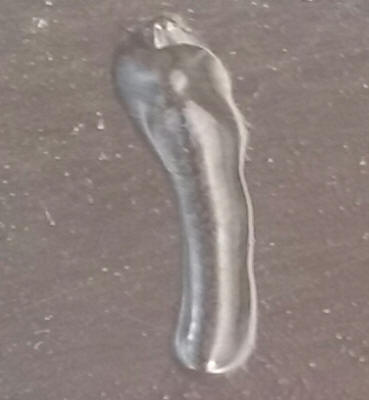 |
|
Re: Can you tell me what this is please???
7/9/17
Wow a flatworm?
<Yes; look in your reference works, the Net.>
Thank you very much for your help, and advice. I will be showing it to my
veterinarian.
<Ah, good. BobF>
|
|
What the heck is this?! 2/13/17
I walked in to find this crazy white worm lookin back at me. It is probably
about 2 inches long and my Beta is scared half to death of it. What is it
and is it dangerous? I keep up with the tank cleanliness and don't over feed
my fish. What else could I do to prevent this from happening again?
-Hannah
<It's an earthworm or something similar (i.e., an oligochaete). Probably
unhappy being underwater, though there are one or two truly aquatic species
that sometimes appear in batches of live food. If it's an earthworm, could
you could kindly return it to the nearest compost heap or clean patch of
soil, that'd be great. Earthworms are fantastic animals. There's a great
book about them -- "The Earth Moved: On the Remarkable Achievements of
Earthworms" -- that I'd recommend to anyone. Aquatic Oligochaetes should be
returned to streams or shallow ponds. Compare and contrast your creature to
photos of the Oligochaetes native to your particular country and act
accordingly. Cheers, Neale.>
|
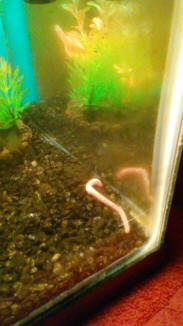
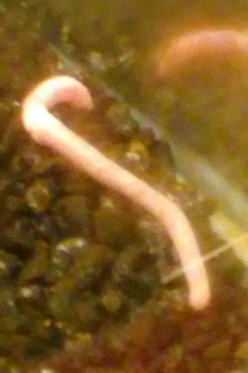 |
FW Worm ID; no pic or rdg. 10/2/15
Was wanting to ask about a worm like creature I discovered in my tank internal
filter inlet tonight it was about 3/4 inch brown in colour when I
grabbed it it stretched to about 5-6 inches while attaching itself by a sucker
mouth
<Ooh.... was going to key Oligochaete; now.... Hirudinean>
but only at one end though wiggling around attached to the glass as i couldn't
get a grip I pulled it out got rid of it then I removed the fish some pregnant
platies I planned to birth put them back in main tank the tank in question was
used to temporarily house a juvenile breeding stock of expensive Plecos
previously to this these have now moved to larger
setup along with some tetras and tank was empty of fish before the platies went
in my main concern is will these be a risk of harm to the previously housed
Plecos or have been transferred in anyway to the bigger Pleco setup if so how do
I eradicate them also had a snail issue in this tank if you could advise me asap
thanks Teresa
<Read here:
http://www.wetwebmedia.com/fwsubwebindex/leechesfwf.htm
Bob Fenner>
White/clear "worms" in tank 7/19/15
Greetings. I just cleaned my daughters fish tank and the water I
replaced it with came from a natural spring.
<Do check water chemistry. This isn't an ideal approach.>
After filling the clean tank I noticed there were hundreds, if not
thousands, of small (about 1/4 to 1/2 in) white /clear "worms" (not sure
if they're worms or some insect larvae).
<Cool!>
My main concern is that my children and I drank from the spring before I
realized these were in it.
<Apparently haven't done any harm so far?>
Anyway, just trying to figure out what they are. Any help would be
greatly appreciated.
<From this blurry photo, not a chance. But nematodes, Nematomorphs,
Oligochaetes and insect larvae are all possibilities. Grab a microscope
(most high schools and colleges have these, if you don't) and look for
the relevant features: segments and bristles for Oligochaetes, lack of
segmentation for nematodes, and so on. Do you know Buchsbaum's "Animals
Without Backbones"? It's a classic primer that covers the basics of each
taxonomic group in adequate depth. Older editions (30s-60s) are
extremely accessible to non-experts with an open mind.>
One other note, the fish in the tank seem to like eating these things.
<Indeed they will.>
Also some appear "dead" as they don't seem to be moving and others are
definitely moving in a squiggly worm-like fashion.
<Your analysis seems reasonable.>
Thanks
<Most welcome. Neale.>
Nematode worms 6/19/15
Dear WWM crew,
I happened upon your site following several searches to try and identify the
worm-like creatures I found on the bottom of my outdoor swimming pool.
I realize your site is for aquarium enthusiasts, but your specialists seem
really knowledgeable about worms and larvae, unlike most of the drivel I find in
"Yahoo Answer-like" web postings. Could you help identify the fast wriggling
creatures in the attached video, <insect
pool larv.mov> and recommend how I can get rid of them? They inhabit a 100ft
long outdoor swimming pool for recreational swimming and most users would
probably not like to share their swimming enjoyment with these creatures.
Thank you for your expertise!
Best regards,
Marc de Beer
<There isn't enough detail to say what sort of "worms" these are, whether
annelids, nematodes, Nematomorpha or insect larvae. Nematomorphs are pretty
common though, and generally harmless to us since they infect different sorts of
animals. Unfortunately, chlorine levels in pools are not normally high enough to
kill the durable eggs of some "worms", and insect larvae may appear repeatedly
because the flies, mosquitoes and other species can come to a clean pool and lay
their eggs there. In short, there isn't a one-shot chemical solution to these.
Net them out, and in particular, remove potential hosts as quickly as you can to
prevent possible reinfection -- typical hosts for Nematomorpha are insects
including flies, crickets,
beetles and so on. Cheers, Neale.>
<From the motion of the animal in your MOV, am pretty sure this/these
are insect larva/e... See WWM re. Bob Fenner>
Re: Nematode worms 6/20/15
Thank you so much!
<Welcome>
Best regards,
Marc
<Simple chlorine shocking procedure will very likely rid your system of these
larval insects. BobF>
|
Hair like worms ,not Planaria...
2/20/15
I've read everywhere that these worms are Planaria and harmless.
<They're not. These ones are almost certainly freshwater Oligochaetes.
Again, harmless, and likely in most mature tanks.>
I first noticed them when they were not there then they were literally
within 20min I had probably 1000 or so, my whole tank looked like it was
full of rice length hair thin worms. This happened on a Sunday. I
cleaned the tank, rocks, plants, and all decore refilled ,treated and
all was good. I layer off feeding (freeze dried blood worms) as much and
less often to prevent over feeding....guess what, they came back, not as
great in number but noticeable. I took a pipette and sucked a few up and
viewed under a microscope at 50x they do not look like Planaria...they
have feet. I need to know if these will kill my fish and how to keep
them gone.
<No, they won't harm your fish. Dosing the tank with an anti-helminth
medication (such as Prazi Pro) might eliminate them, but then, as has to
be stated loud and clear, all medications are poisons, and using them
needlessly is a potential risk. Will these worms do any harm? No,
freshwater Oligochaetes are mostly scavengers or micro predators,
consuming decaying organic matter and the very smallest of organisms.
They are actually beneficial animals in most cases, though overfeeding
or under-cleaning the aquarium may provide them with so much food their
numbers multiply rapidly. A few wouldn't be anything to worry about
though.
Cheers, Neale.> |
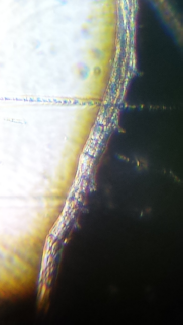
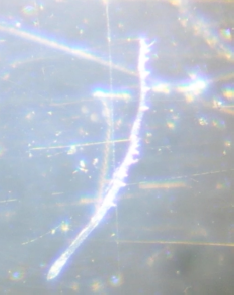
See the segments? |
|
Re: Hair like worms ,not Planaria... 2/21/15
Thank you so much. I actually put 3 of them in a drop of water to
observe their behavior towards each other when their environment was
constricted enough to force them to be in close proximity to each other
and I guess like everything else in the universe, limited space creates
much tension.
<As Frank Herbert liked to point out, the most severe threat to a
species comes from its own kind, not from predators or competitors.
Limit the supply of oxygen, as you did, and it's every man (or worm) for
himself.>
They literally began fighting each other, attacking, biting and
violently twisting up within themselves.
<I'd be wary about reading too much into what your little Shai-Huluds
got up to in there. Lack of oxygen and rapid increase in temperature
under a microscope can cause many non-unicellular animals to behave very
aberrantly, reflecting the severe stress such warm, bright environments
cause on animals accustomed to cool, dark places.>
I take pride in my little 20 gallon tank taking 4 hours to clean it when
needed, bi weekly 20% water changes, conditioners and I don't use
medical chem.s normally. I have tried a Mediflex treatment for a minor
fin issue from nipping, which helped but I don't like running a no
carbon filter for 7 days. I really appreciate your rapid response and
setting my mind at ease. I love my little guys and feel they are more
than just fish as one major pet store chain tried to convince me of.
<Yikes! Glad your enjoyment of the hobby has developed and become more
rewarding than this particular retailer might have supposed. Cheers,
Neale.> |
|
|

